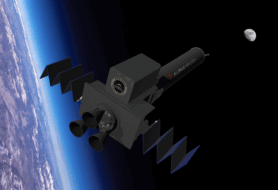Space companies are not-so-quietly preparing to build crucial infrastructure for Mars exploration.
On Aug. 7, Rocket Lab CEO Peter Beck told investors on an earnings call about his company’s interest in building a Mars telecommunications orbiter (MTO)—a spacecraft called for in President Donald Trump’s policy bill, which became law in July.
Five days later, Jeff Bezos’ Blue Origin threw its hat in the ring with a short blog post saying it would adapt its Blue Ring spacecraft to serve as an MTO for NASA, which has yet to formally request proposals.
Yo, MTO: The bill sets aside $700M for NASA to hire a company on a fixed-price contract to build an MTO. The orbiter will need to provide communications for efforts to return samples waiting in limbo on Mars, as well as future crewed and robotic missions. The law specifies that a contractor must be selected in FY26 and deliver the MTO by the end of 2028.
Talk priority: Notably, that contractor needs to have “proposed a separate, independently launched Mars telecommunication orbiter supporting an end-to-end Mars sample return mission” at the time when NASA solicited private sector help fixing NASA’s now-abandoned MSR program in 2024.
At least eight companies received funding for MSR studies last year: Rocket Lab, Lockheed Martin, Blue Origin, Quantum Space, L3Harris, Northrop Grumman, SpaceX and Whittinghill Aerospace. It’s not clear which ones proposed their own MTO solutions besides Blue Origin, Rocket Lab and Lockheed Martin.
Back to the lab: Beck has aggressively pushed Rocket Lab into planetary science, including the CAPSTONE lunar mission, the two ESCAPADE satellites heading to Mars next month after a year’s wait for Blue Origin’s New Glenn rocket, and a mission to Venus slated for 2026.
Rocket Lab pushed its way into the 2024 MSR study project a month after the other competitors, and Beck has repeatedly called on NASA to take up his company’s plan. He says it would cost $4B, much less than the $11B price tag that led the original mission to be cancelled.
“Our whole technology stack has been built with addressing planetary requirements in mind, and executing on it,” Richard French, a Rocket Lab vice president tasked with space systems business development, told Payload.
Rocket Lab stands out, French added, because it isn’t working on major components of NASA’s Artemis lunar return like its competitors. “We’ve got capacity—we’re not burdened by having all of these Artemis obligations; this can be a priority for us, and we can be trusted by NASA to deliver.”
Ring around the rosie: Blue Origin’s MTO plan centers on Blue Ring, its all-things-to-all-people space platform that is expected to make its first trip to orbit in 2026 on an SDA demonstration mission.
The company declined to talk about its idea, but the blog post sketches out a deep-space version of Blue Ring. The vehicle aims to carry 1 metric ton of payload to Mars orbit to act as a telecom relay, while also deploying smaller satellites to provide network coverage of the Red Planet.
Experience counts: When asked about MTO, Whitley Poyser, Lockheed Martin’s director of deep space exploration, noted that her company built and operates NASA’s current science and communications orbiters at Mars.
“With our extensive experience supporting Mars missions, we are well-positioned for this opportunity and are currently developing options to support the agency’s needs for the next generation of Mars communications capabilities,” Poyser said.
In the red? Private companies are eager to see the LEO and lunar business models behind NASA’s public-private partnerships come to Mars, but the companies are figuring out exactly how much risk they can take on in deep space.
“There’s a lot of commercial opportunity here, and we want to see all the lessons of CLPS applied: Fixed price…some cost and schedule risk allocation on the industry side,” French said. “But we also think [Mars] needs to be a public-private partnership—the US government in particular really is the primary user of this, and so the program has to be capitalized appropriately.”




